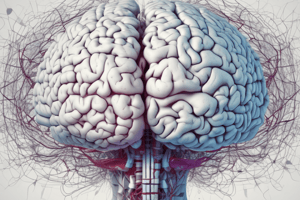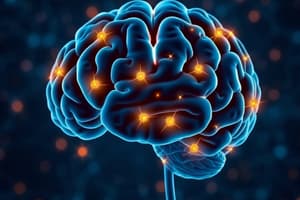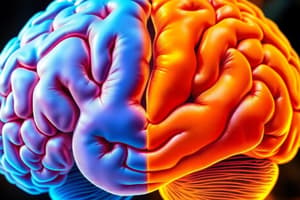Podcast
Questions and Answers
Which of the following best describes cognitive control?
Which of the following best describes cognitive control?
- The ability to suppress unwanted thoughts.
- The ability to flexibly coordinate behavior towards internal goals. (correct)
- The ability to maintain information briefly.
- The ability to quickly react to external stimuli.
How do gains in cognitive control typically manifest from childhood to adulthood?
How do gains in cognitive control typically manifest from childhood to adulthood?
- By refinement of existing cognitive functions. (correct)
- By a steady decline in performance.
- By a complete shift to new cognitive functions.
- By a decrease in variability.
What characterizes the pubertal period across different cultures and species?
What characterizes the pubertal period across different cultures and species?
- A strong preference for long-term rewards.
- A decrease in sensation-seeking behaviors.
- An avoidance of risk-taking situations.
- An increase in sensation- and novelty-seeking behaviors. (correct)
Which components are integrated to provide cognitive control?
Which components are integrated to provide cognitive control?
What is the primary focus of fMRI studies that investigate age-related differences in inhibitory control?
What is the primary focus of fMRI studies that investigate age-related differences in inhibitory control?
How does prefrontal engagement typically change with age during inhibitory control tasks?
How does prefrontal engagement typically change with age during inhibitory control tasks?
What role does the dorsal anterior cingulate cortex (dACC) play in inhibitory control?
What role does the dorsal anterior cingulate cortex (dACC) play in inhibitory control?
Why is the dACC considered an anatomical hub?
Why is the dACC considered an anatomical hub?
What aspect of error monitoring shows increased ability throughout adolescence?
What aspect of error monitoring shows increased ability throughout adolescence?
Which regions are implicated in supporting the mnemonic aspects of working memory?
Which regions are implicated in supporting the mnemonic aspects of working memory?
How do developmental differences in working memory manifest when manipulation or distraction suppression is required?
How do developmental differences in working memory manifest when manipulation or distraction suppression is required?
How do incentives influence cognitive control performance during adolescence?
How do incentives influence cognitive control performance during adolescence?
What suggests that core components of cognitive control continue to develop during adolescence?
What suggests that core components of cognitive control continue to develop during adolescence?
Structural networks provide the basis for what?
Structural networks provide the basis for what?
What is notable about adolescence regarding brain plasticity?
What is notable about adolescence regarding brain plasticity?
How are developmental changes in brain networks typically assessed?
How are developmental changes in brain networks typically assessed?
What happens to structural network segregation from adolescence to adulthood?
What happens to structural network segregation from adolescence to adulthood?
What provides a backbone for network specialization and integration?
What provides a backbone for network specialization and integration?
What is a primary feature of age-related improvements in cognitive control concerning functional and structural networks?
What is a primary feature of age-related improvements in cognitive control concerning functional and structural networks?
What dynamic interaction is proposed to underlie the maturation of cognitive control?
What dynamic interaction is proposed to underlie the maturation of cognitive control?
What is one of the key structural changes that continue through adolescence which are pivotal for cognitive control?
What is one of the key structural changes that continue through adolescence which are pivotal for cognitive control?
The influence of dopamine and GABA has what affect on cortical networks?
The influence of dopamine and GABA has what affect on cortical networks?
What role do GABA interneurons play in cortical function.
What role do GABA interneurons play in cortical function.
Which of the following aligns with how DA influences the mesofrontal system?
Which of the following aligns with how DA influences the mesofrontal system?
What is observed that enhances sensitivity to reward stimuli?
What is observed that enhances sensitivity to reward stimuli?
Flashcards
Cognitive control
Cognitive control
The ability to flexibly coordinate behavior in the service of internal goals.
Working Memory
Working Memory
Goal-relevant information maintenance
Inhibitory control
Inhibitory control
The ability to suppress a prepotent, goal-incompatible response.
Performance monitoring
Performance monitoring
Signup and view all the flashcards
Development of Cognitive Control
Development of Cognitive Control
Signup and view all the flashcards
Pubertal Period
Pubertal Period
Signup and view all the flashcards
Cognitive control
Cognitive control
Signup and view all the flashcards
Dorsal anterior cingulate cortex (dACC)
Dorsal anterior cingulate cortex (dACC)
Signup and view all the flashcards
Developmental Changes in Brain Networks
Developmental Changes in Brain Networks
Signup and view all the flashcards
Structural Network Topology
Structural Network Topology
Signup and view all the flashcards
Small-world architecture
Small-world architecture
Signup and view all the flashcards
Hubs
Hubs
Signup and view all the flashcards
Network segregation
Network segregation
Signup and view all the flashcards
Developmental Improvements In Cognition
Developmental Improvements In Cognition
Signup and view all the flashcards
Maturational Changes in Network Dynamics
Maturational Changes in Network Dynamics
Signup and view all the flashcards
Gray Matter
Gray Matter
Signup and view all the flashcards
Myelination
Myelination
Signup and view all the flashcards
GABA (Gamma-aminobutyric acid)
GABA (Gamma-aminobutyric acid)
Signup and view all the flashcards
DA System Dopaminergic
DA System Dopaminergic
Signup and view all the flashcards
Mesofrontal DA
Mesofrontal DA
Signup and view all the flashcards
Reward contingency
Reward contingency
Signup and view all the flashcards
Experience accumulates
Experience accumulates
Signup and view all the flashcards
Cellular-Level Changes
Cellular-Level Changes
Signup and view all the flashcards
Cortical GABA Interneurons
Cortical GABA Interneurons
Signup and view all the flashcards
DA System
DA System
Signup and view all the flashcards
Study Notes
Overview
- Brain systems change dynamically at cellular, circuit, and systems levels, which underlies the shift to adult cognitive control.
- Examines existing data to present a new framework for understanding the brain's role in cognitive control development.
- Cognitive control is often better in adulthood through flexible combination of component processes like:
- Inhibitory control.
- Performance monitoring.
- Working memory.
- Brain structure matures because of interactions of dopaminergic and GABAergic systems that contribute to:
- Enhanced network synchronization
- Improved signal-to-noise ratio.
- Specialization and strengthened connectivity in networks promote the shift to adult cognitive control.
- Adolescence is an adaptive period of heightened experience-seeking that allows for brain specialization that support cognitive control.
Keywords
- Development
- Cognitive control
- Networks
- Dopamine
- GABA
- Inhibition
- Working memory
- Performance monitoring
Introduction
- Describes cognitive control as the ability to coordinate behavior in a flexible, voluntary, and adaptive manner to achieve internal goals in a noisy and changing environment.
- Cognitive control relies on separate but interacting components:
- Task-set switching
- Task-set maintenance
- Adaptive gating
- Working memory
- Response selection
- Response inhibition
- Flexible integration of processes supporting online maintenance of goal-relevant information (working memory).
- These processes include suppression of competing, goal-irrelevant information (inhibitory control), and continuous evaluation of selected actions (performance monitoring).
Availability and Cognitive Control
- Cognitive control is present early in development, with implementation improving into adulthood.
- Development does not mean a new ability emerges, but that an existing set of cognitive functions continue to refine.
- This is supported by improved accuracy rates into adulthood on cognitive control tasks.
- Adolescents show dramatic improvements, but control is more variable than in adults.
- The shift to adult control is specifically interesting for understanding healthy and impaired cognitive development.
- Adolescence often happens between 10-16 years commonly.
- Puberty includes increased sensation and novelty seeking tendencies driven by desire for short-term rewards.
- The sensation and novelty behavior can lead to risk-taking and increased mortality rates, along with having implications for juvenile law.
- Major psychopathology can impair cognitive control.
- Limitations in cognitive control are thought to play a role in:
- Adolescent risk-taking.
- Emergence of psychopathology.
- Integration of component processes like inhibitory control, working memory, and performance monitoring, as well as modulation by motivational systems supports cognitive control.
- Researchers have studied these independently
- Neuroimaging has built a framework to look at relationships between brain systems supporting components of cognitive control.
- Development of individual component processes of cognitive control and maturation of associated brain networks are presented.
- There is evidence for an interactive component model of cognitive control.
- Brain systems-level change mechanisms extend understanding of the interplay between control and motivational systems in adolescence.
- Changes in dopaminergic signaling during adolescence, help improve the integration and maturation of cognitive control components.
Inhibitory Control
- Describes inhibitory control as the capacity to suppress a dominant, goal-incompatible response in favor of a planned, goal-directed response
- Even in infancy, children can exert inhibitory control.
- Throughout childhood and adolescence, inhibitory error rates decline
- fMRI studies have focused predominantly on the prefrontal cortex's function when characterizing age-related changes in core inhibitory control circuitry activation.
- Studies have found developmental increases and decreases in recruitment of prefrontal regions
- The effect of changes in how prefrontal systems impact the development of inhibitory control is unknown.
- More recent studies have found decreased prefrontal engagement with age correlating to improved performance
- Task-related prefrontal engagement decreased from childhood to adolescence in a longitudinal fMRI study investigating the performance of inhibitory control
- It can reflect reduced effort with age, paralleling adults under higher cognitive load
- Improved synchronization among relevant prefrontal systems may lessen local processing needs, which could lessen BOLD response.
- Activation increases with the dorsal anterior cingulate cortex (dACC).
- These results suggest that inhibitory control during adolescence increases from performance monitoring in the dACC.
- This is consistent with cross-sectional fMRI and extensive EEG studies.
- The ACC shows increased involvement as humans age when doing inhibitory control tasks, underlining how important integration is between component processes of cognitive control.
Performance Monitoring
- Performance monitoring focuses on the ability to supervise actions and their consequences.
- Conflict and error processing which rely on the ACC are needed.
- dACC assists inhibitory control through supervisory processing.
- Dorsal regions of the ACC connect strongly with premotor, supplementary motor & primary motor regions; insula; nucleus accumbens; dorsal striatum; lateral basal nucleus of the amygdala.
- Nociceptive data is received from the spinothalamic tract, and the dACC becomes an anatomical hub that combines data about pain, negative affect, and performance monitoring
- This may serve as a central data hub for networks that potentially show drawn-out development through adolescence.
- Increased ability to monitor performance is considered a key aspect of development.
- Increased dACC recruitment has been found in many studies.
- Electrophysiological data demonstrates an increased capability to monitor performance throughout adolescence via increased error-related negativity when errors occur.
- Due to the supervisory role of the performance monitoring system, developmental improvements are likely to help development for other components of cognitive control.
Working Memory
- The ability to maintain a representation online to guide goal-directed behavior.
- Frontoparietal and sensory regions maintain organization, supervision, and mnemonic qualities
- accuracy improves from childhood into late adolescence
- Overall accuracy appeared adult-like by adolescence in an oculomotor spatial working memory task.
- FMRI studies indicate that prefrontal-parietal cortical circuitry is utilized by children and adults alike
- Enhancements are related to enhancement of the recruitment of this circuitry.
- Improvements were related to increased activation of executive network regions and deactivation of default mode network regions.
- Developmental differences are greatest when manipulation or distraction suppression is needed.
- Integration of inhibitory control processes supports mature working memory.
Motivation via Rewards
- Importantly, cognitive control depends on interactions with reward circuitry given the presence of incentives.
- Inhibitory management improves to adult like levels when correct responses are rewarded during adolescence.
- In addition to increased activation of motivational systems(ex: ventral striatum), adolescents recruit control regions to a greater extent than adults when paired with a reward contingency.
- Motivational structures may boost behaviors to collect a reward, including cognitive management skills.
Network Development
- Cognitive control is driven by specialized networks
- Improvements are increasingly due to functional collaboration among specialized networks.
- Graph theoretical approaches allow researchers to define regional interactions from the temporal signature of spontaneous brain activity.
- Further this can be used to describe/understand how these interactions change with development.
- Structural networks are white matter pathways connecting localized brain regions and give a base for functional integration.
- The predisposition for brain regions to modulate activation with similar temporal dynamics at rest or during a task is refered to as functional networks
- Structural and functional networks are related, but function modulates structure.
- Basic aspects of structural and functional network are there before birth
- Throughout live they support greater systems-level integration among increasingly specialized networks by going through developmental modifications
- Body, brain, and environment interactions have an affect
- Plasticity facilitates specialization in which adolescence is notable as a period
- Developmental changes are measured by graph theoretical measurements that include:
- Small-worldness.
- Community structure.
- Hubness.
- Rich-clubness.
- Small-world architecture promotes efficient local and global information processing though highly clustered subnetworks Network segregation is the clustering of densely intraconnected processing brain regions that are specialized.
- Network integration relates to combining specialized data from distributed brain regions and networks.
- Both have key roles during development.
- Critical brain regions for network integration are refered to as hubs.
- Hubs make an intraconnected network between themselves.
- The intraconnected network supports global brain communication and interconnectivity.
Network Development in Adolescence
- Core components of structural network topology are evident by infancy
- Structural network segregation decreases from 12 to 30
- Network integration increases in adolescence
- Rich clubs become evident by 30 weeks gestation
- There is a proliferation of connections until childhood
- Aspects of rich club organization stabilize by childhood
- With adolescence additional nodes are integrated
- Canonical adult functional networks are observable by age two
- Small-worldness is present throughout childhood
- Hubs localize from the sensory cortices to the association cortices, changing in childhood
- Organization, number, and connectivity of the hub architecture become adult like in adolescence
- Functional rich-club organization becomes evident with slight increases in participating nodes in adulthood
- Foundational architecture provides a backbone for network specialization and integration with its early stabilization hub
- Increased integration is seen in connectivity between prefrontal hub regions and increased white matter integrity of frontoparietal tracts.
- Cognitive control supported by module integration of segregated parts of processes.
- Findings that children/adults show shift in prominence of local to distributed connectivity engagement that indicate changes were underminded from spurious effect.
- Modular organization has to be defined by the network's structure, rather than distance - Then integration/segregation defined by analytical ways sensitive to network structure
Neural Correlations and Ability for Cognitive Control
- Prolonged maturation of cognitive control ability happens with neural correlates
- Functional/structural network architecture in the brain supports interregional integration.
- Integration critical for mature cognitive management Integration of frontoparietal and cingulo-opercular improves with working memory
- Performance is associated with interaction between default mode network and those networks.
- Interactive component model based on dynamic interoperation of systems which underlie cognitive management (working memory, inhibitory control, monitoring).
- Components include distinct/overlapping brain regions that compliment and are integrated with other.
- Pairwise relation/regions bring connectivity weight that are current on task/set
- Connectivity patterns that facilitate task achievement reinforce it.
- DA Hebbian increases signal to noise/synchrony, which refines brain network structure
- During development these parts reinforce the ability for components to be timely/flexible. This is because of reduced reaction times.
Cognitive Control Development: Specialization of Cognitive Control
System level
- The brain shows alteration at molecular levels, gray matter reduction, and synaptic pruning
- Gray matter shows development through neocortex/subcortical, which includes striatum & thalamus' Enhancement of signal-noise ratio by pruning excess connections supporting complex cognitive control
- White matter pathways demonstrates linear increases (occipital-parietal)
- Integrity and speed significantly increases from myelination
- Positively correlated white matter integrity relates to cognitive performance + working memory.
Conclusion
- Findings suggest adolescent brain starting to reach stability in gray matter thinning, pruning, and increased myelination
- Changes facilitate new ability to function as an adult, though it's unreliable:excess synapses with poor neuronal may limit function.
Cellular - Level Changes
- Interactions between dopaminergic and reward control function with (GABA)ergic system network shaping
- Age shows changes in dopaminergic and (GABA)ergic systems changes by way of plasticity.
- Substantive change within systems are present throughout life, but specifically in adolescence
- Cortical GABA neurons set synchronized frequency while excitatory helps cognitive function (Gonzalez/lewis)
- Neocortical (GABA)ergic changes over development + synpatic markers improving too
- PV cells inhibitory that synapse post pyramidal
- Inhibitory pyramidal function has cellular mechanism underlying increased synchrony and peradolescence
- Increased (GABA) expression is in adolescence = higher synchrony through Hebbian to develop (EEG Uhthaas).
- Neuronal transitions are favored with external signals, like vision functions.
- DA function undergoes changes by impacting striatum and influence reward/emotions with limb cortex/executive (haber) Processing cognition/rewards also come because of this
- Expression synth receptors peaks during teen age/adolescence
- Cortical increase throughout (DLPFC and dACC) for activity. The peaks are unique to development of the teens
Studying That Suits You
Use AI to generate personalized quizzes and flashcards to suit your learning preferences.





